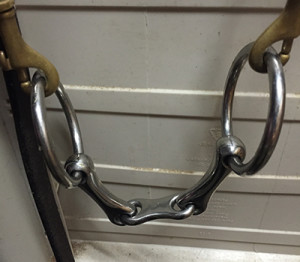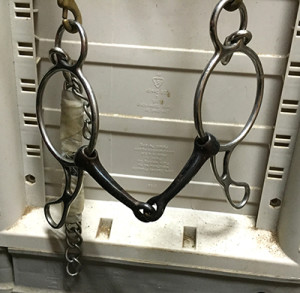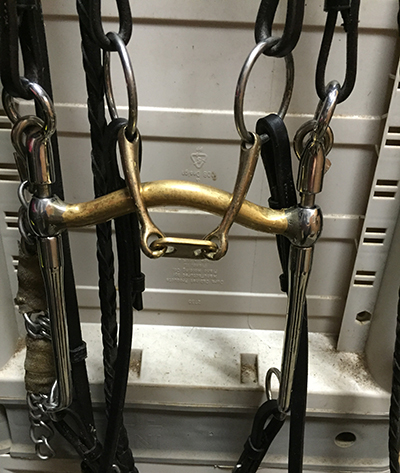At the clinic, we had a session on bits. Honestly, it wasn’t long enough… the topic of bits could take hours and hours to really cover, since there are so many different bits, so many “what ifs,” and of course, horses have their opinions, too, which might not match our expectations.
So since the subject matter is deep enough and broad enough to fill a book, I’m not going to even attempt to cover everything in one short blog post. Instead, this will just be an overview of my favorite bits, why I use them, and what they do for my particular horse. Remember, your horse and your hands are different, so these bits might not work for you, or they might work differently. But if you’re stuck and looking to try something new, this might give you some ideas.
Working Snaffle
My horse’s daily work bit is a smooth French link O-ring snaffle. I love this bit! I bought it several years ago and have used it as my main “go-to” bit since then. All of my horses that have worn this bit were very different, from green to seasoned, heavy to light. But none of them came to me working in this bit; they all worked fairly well in their original bits. So why did I switch?

I like to think of a horse “graduating” to a smoother bit instead of moving to a harsher bit. So in my mind, taking a horse from a stronger bit to a more mild bit means the horse has advanced forward in his or her training. They’ve learned to bend, keep their neck and jaw soft, and not push through the bit. If they try to push through, they are easily softened with a mild aid. When a horse is soft and yielding, only the mildest of bits are necessary. Also, if a horse is really heavy in the bridle, it could be a defensive action. They are pulling on the rider so they have more control over the pressure in their mouth. I’ve found that when I switch a heavy horse to a milder bit, after they figure out the bit won’t hurt them anymore, and I’ve done some work teaching them to bend and relax, they will stop pulling.
So why would I use a French link instead of a smooth snaffle? I visualize a snaffle bit as “sliding” in the mouth. It’s not stationary, with each side moving independently. When you pull on a rein, the entire bit will slide towards that pull. A single jointed snaffle bit doesn’t follow the contours of the horse’s mouth. The bit is broken in the middle, so if you’re pulling hard on one rein, the joint of the bit will want to “turn the corner” and ends up at the corner of the horse’s mouth. If you’re using a 5″ snaffle, this means that, from the ring on the “non pulling” side of the bit to the joint, which is now on the pulling side, the horse’s mouth is being squished down to 2 1/2″! To accommodate that, they have to open their mouth (so if you have a horse who gapes his mouth, this might be a cause). If the horse is wearing a tight cavesson to hold their mouth closed, I can’t imagine this being comfortable in the least. A French link bit, because it has multiple joints, will conform to the mouth instead of trying to find the place of least resistance (i.e. the corner of the mouth). Also, the break in a snaffle bit is pointed. I know if I had a bit in my mouth, I wouldn’t want that pointed part “sliding” around on the roof of my mouth. So I prefer a French link.
Elevator Bit
This is a fairly common bit in the reining and western pleasure worlds. It’s called an elevator bit or a western gag bit, because when you pull on the reins, the mouthpiece slides up the sides of the shank, which creates an upward sensation in the mouth, and at the same time, a downward pull on the poll. Western riders use it to lower a head. I use it to lighten a horse who is pulling, resulting in the head raising up (while still keeping the horse round and supple).

How can one bit be used to lower a head AND raise a head? Saddle seat horses are usually taught how to wear an overcheck or sidecheck. They understand that an “upwards” pull in their mouth means “raise my head.” The downward pull this bit exerts on their poll is a secondary sensation that they will usually ignore unless rewarded for responding to it. That is why a gag snaffle on a double bridle works to raise a head instead of lower it. They are feeling both things (bit moving up, bridle pulling down) but they respond to the “up” instead of the down. So when my horse lowers his head TOO far, a gentle tug is enough to raise him back up. This mimics, in a way, the tug he might get on the bridoon bit of his double bridle if I want him to raise up while I’m riding him (he does not wear a gag in his double bridle).
I work my horse in this bit about once a week as an alternative to the French link snaffle. Even in this bit, I want my horse’s head fairly low and his back up and rounded. However, in the elevator bit, he will have a slightly higher headset than in his work snaffle. It also allows me to work him in a leverage bit where he can feel the curb chain engage and disengage as I work the bit. My horse doesn’t care too much for curb chains, so the more he wears one, the more accepting of them he becomes.
Now you might be wondering why I like a bit with a single joint, when a few paragraphs ago I said I don’t. Because this bit has shanks, the mouthpiece cannot slide side to side the same way it slides on a snaffle bit. If you pull REALLY REALLY hard it might – but I don’t use this on horses who aren’t already appropriately responsive to their working snaffle.
This is a great bit for keeping a horse light in the bridle. They feel a variety of sensations in their mouth, depending on how you use the bit, and it translates well over to riding in a full bridle. You can use it while riding, driving, or long lining, and it’s usually used without a cavesson.
Full Bridle
This is my horse’s full bridle. You can see he wears very mild bits. The bridoon is a smooth Dr. Bristol, and the curb is a forward tilted, slip shank mullen with a wrapped curb chain. I’ve been trying for years to find a bridoon-sized French link, but to no avail. I’d prefer that over the Dr. Bristol because of the way the center tab acts on the tongue, but this is as close as I can get right now.

I arrived at this curb bit after trying about a dozen different curbs. He wore a medium Tom Thumb curb with stationary shanks when I bought him about a year ago, and that worked well for a short while. However, my hands are different than the trainer who had him before me, so the bits he used eventually ended up not working for me. I tried everything from a windsucking bit to various thicknesses of mullens to even a high port frog (which he HATED). The mullens were the closest – he didn’t try to argue with them – but not quite right. He was almost too comfortable and didn’t really respond how I wanted. I knew a forward tilt would engage sooner in his mouth, so I wanted to go that route, and thinking about my love for bits that can easily move in the mouth, I decided to try a loose shank curb. Voila! He is comfortable in it, but the movement of the bit keeps him happy and attentive.
The curb is hung slightly lower than normal so my horse can “carry” it himself. He will hold it where he wants it. He’s much more relaxed in this bit, very responsive without being overly reactive. His mouth stays soft and I can use the bit effectively. This is the first loose shank curb I’ve owned, but I think I’ll be adding more to my inventory in the coming years!
Everything above is just from my own personal experience. Like I said at the beginning, every rider and every horse are different, so your experience and knowledge could be vastly different from mine (I definitely don’t know everything and love to learn!). So if you have any advice or insight you’d like to add, please share your thoughts with our readers in the comments below!
- Fixing the One-Sided Horse - March 28, 2016
- Running Martingales, Draw Reins and German Martingales – A Physics Lesson - November 23, 2015
- What to Do in the Off Season - October 14, 2015
